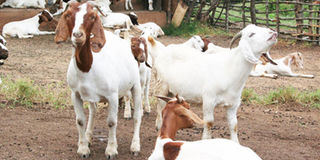Making a case for goat’s milk

Goat meat has earned Baringo the name “Goat County” and visitors from far and wide make a stopover at Koriema shopping centre on the Kabarnet-Marigat road to have a bite of this unique delicacy. FILE PHOTO |
What you need to know:
When it comes to choosing what milk people should consume, cow’s milk is the obvious choice. James Ssematimba explains why goat’s milk might be better than cow’s.
In some societies, seeing someone milking a goat is regarded as a taboo. Whoever does so is regarded poor, if not a reject in the society. Some people do not believe that it is normal to drink goat milk.
Goat’s milk is only taken in extreme cases where a mother has died and has left behind a breastfeeding baby. One of the misconceptions on goat’s milk is that it has a peculiar “goaty” smell. But this is because of the presence of the buck (male) goat, whose scent glands are rather smelly and may indeed lead to the “goaty” milk people object to if it is present at milking time.
However, the powerful odour from the male can be avoided. It is advisable that dairy goats are kept separate from the male. Once this is done, the milk produced in the absence of a buck should bear no objectionable odour.
Today, goat’s milk is slowly making inroads in mainstream dairy production. In fact, I have seen goat’s milk in powder form on the shelves of various supermarkets meant for babies between zero to six months. Truth is, goat’s milk has been consumed for ages especially in mountainous areas of the Rwenzoris and around Mt Elgon amongst the Bagisu.
Available research shows that human bodies are not designed to digest cows’ milk or goat’s milk. they are meant to consume breast milk for the first several months, and then move on to other foods. This is because the human digestive system cannot produce the enzymes necessary to digest lactose, the sugar like fat in animal milk, a common case with people whose stomachs “cannot tolerate milk”.
It must be pointed out that dairy products are a good source of protein but are also high in fat, acid, enhance mucous-forming and are difficult for many to digest. Cow’s milk products are believed to contribute to the increasingly early onset of puberty, as well as adult fertility problems. And sensitivity to milk products may be related to asthma, congestion, inflammation, digestive illness and acidity.
Milk upsets the acidity in the body and boosts mucous production, contributing to inflammation and congestion. Those with a cold, sore throat or skin breakouts may find an improvement in their health by avoiding milk and milk products and asthmatics, in particular, can benefit from avoiding milk products entirely.
Goat’s milk vs cow’s milk
Research findings indicate that there are several advantages of avoiding cow’s milk in favour of goat’s milk. The nutrient content of goat’s milk is slightly less than a cow’s.
•Goat’s milk is more digestible and nourishing because the fats in goat’s milk are a fifth the size of those from cow’s milk, making it easily tolerated by those with stubborn digestive systems. Also goat’s milk has no cream because of the less fat content.
•Goat’s milk is tolerated by people with damaged livers because of the smaller fat content and it is naturally homogenised. Goat’s milk contains more highly evolved cholesterol than cow’s milk, making it more available for absorption to the brain and the body (cholesterol is essential to the health of whiter matter of the brain nerves and is essential in the formation of bile acid).
•Goat’s milk is low on carbohydrates. The inability to digest lactose is a common human condition and milk with less lactose such as goat’s milk is helpful to lactose intolerant individuals. Goat’s milk is closer to human milk in composition and more easily acceptable by babies or those in poor health. Goat’s milk has an alkaline reaction the same as mother’s milk, whereas cow’s milk has an acidic reaction.
•Goat’s milk contains more chlorine and fluorine than any other domestic livestock. Chlorine and fluorine are natural germicides and fluorine assists in preventing diabetes. Also, goat’s milk is better tolerated by the asthmatic and those with allergies.
•The human body is known to absorb goat’s milk protein at a much faster rate than cow’s milk protein. Goat’s milk has the ability to sweeten the intestinal tract and assist with constipation abnormalities.
•Goat’s milk contains a higher evolved carotene (pro-vitamin A), which has been found to have cancer preventing properties.
•Goats are immune to diseases, such as tuberculosis (TB) and their milk is used to actually cure TB because of the inherent TB antibodies. Importantly, goats can survive on less pasture than cows.
•Goats are also suitable for hilly, rocky areas. The poorest of the poor find it easier to keep dairy goats more than dairy cattle because a goat will occupy a smaller area and produce enough milk for the average family.
•A good dairy goat produces about four litres of milk per day.
Dairy goat-rearing is growing in popularity and it is regarded as a “poor man’s cow”. In fact, in some communities in Kyotera and Buwambo in Wakiso District, goat’s milk is regarded highly as having some “medicinal’ properties for HIV/Aids, which, however, has not been ascertained scientifically but can be attributed to the highly digestible and nourishing qualities of goat’s milk, in addition to its germ-killing properties against opportunistic secondary bacterial infections.
Dr James Ssematimba is a Veterinary Expert working with Send a Cow Uganda.




